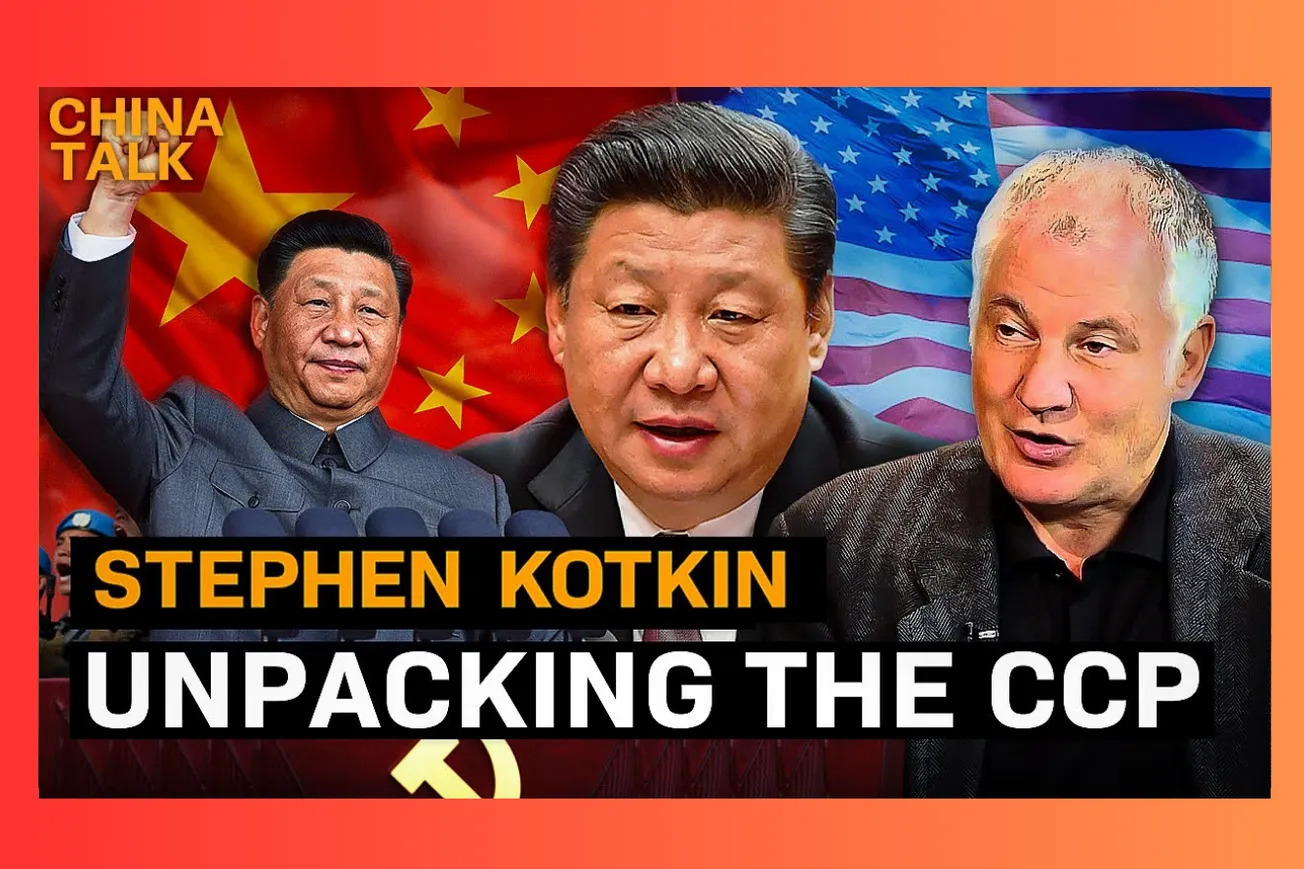Table of Contents
Leading historian Stephen Kotkin reveals why Xi Jinping's greatest fear isn't military confrontation but political alternatives, and why Cold War dynamics offer hope for US-China stability.
Key Takeaways
- The CCP's Party School teaches two dominant subjects: America's supposed decline and preventing Soviet-style collapse in China
- Communism's main threat comes from within - the system is simultaneously all-powerful and brittle, with no stable political reform equilibrium
- Xi Jinping fears "color revolutions" and Western values more than NATO expansion because they threaten the Party's monopoly on power
- Hong Kong represented an existential threat not militarily but as a successful alternative political system on Chinese territory
- Marxism-Leninism has two components: anti-capitalism and anti-imperialism, with the latter never diminishing in Chinese Communist ideology
- The current US-China tension is actually promising because it's based on realistic assessment rather than fairy-tale engagement
- Cold War dynamics are both necessary and beneficial - the alternative is either capitulation or hot war
- Reagan's genius was combining movement conservatism with dealmaking, meeting both dissidents and Communist leaders
- China's "commanding heights" today include the public sphere, education, tech companies, and anything affecting values and party control
- Economic liberalization is possible under Communism, but political liberalization inevitably leads to system collapse
Xi Jinping's Existential Nightmare: Why the Soviet Collapse Haunts China
The most revealing insight into Xi Jinping's worldview comes from understanding what keeps him up at night. It's not American military bases or trade wars - it's the specter of Soviet collapse. As Kotkin explains, Xi's entire political life is dedicated to preventing what happened to the USSR from happening to China.
This obsession shapes everything at the CCP's Central Party School, where there are two absolutely dominant subjects taught to party cadres. The first is the supposed decline of the United States - how America is decadent and represents power of the past. Here's the thing though: this narrative is completely wrong, and more party officials are beginning to realize it thanks to developments like Putin's criminal aggression in Ukraine, which has backfired spectacularly on both Putin and Xi.
But the second subject is even more crucial - it's studying the Soviet collapse from every conceivable angle to ensure it never happens in China. This isn't just academic exercise; it's survival training for the regime. The Communist Party has translated and studied works on Soviet history, including Kotkin's own research, as essential texts for understanding how not to collapse.
- Xi views the Soviet experience as a cautionary tale about ideological competition and historical nihilism
- The party cadres are constantly taught about the dangers of repudiating Communist history and leadership
- Every policy decision is filtered through the lens of regime survival rather than pure effectiveness
- The fear of collapse influences China's approach to economic reform, social control, and international relations
What's fascinating is how this fear creates a kind of strategic paralysis. The regime knows it needs to adapt and modernize, but every reform carries the potential seeds of political liberalization that could spiral beyond control.
The Paradox of Communist Power: All-Powerful Yet Brittle
One of the most brilliant insights from Kotkin's analysis is the fundamental paradox of Leninist systems like China's. The Communist Party is simultaneously all-powerful and incredibly brittle. It's ubiquitous, shadowing every institution whether in government, military, education, or what we might call the quasi-private sector in China.
This creates what Kotkin calls "the organizational weapon" - a system of total control that's also inherently unstable. You can't be half-communist, just like you can't be half-pregnant. The party either maintains its monopoly completely or it begins to unravel. There's no stable middle ground, no political reform equilibrium that allows for gradual democratization while preserving Communist rule.
We've seen this pattern repeatedly throughout Communist history. Hungary in 1956, Czechoslovakia's Prague Spring in 1968, and ultimately Gorbachev's reforms in the Soviet Union - each attempt to liberalize the system while maintaining the Party's monopoly led to its destruction.
- The party's ubiquity creates an appearance of strength but masks fundamental vulnerabilities
- Any political opening creates demands for alternative parties and genuine competition
- Leaders face an impossible choice: crack down and stifle reform, or allow opening and risk system collapse
- The Hungarian and Czechoslovakian experiences show how quickly political liberalization can spiral beyond party control
Gorbachev truly believed in "communism with a human face" - he thought he could liberalize the Communist Party monopoly while keeping it intact. But as Brezhnev had observed decades earlier while watching events in Prague, reform equals counter-revolution. It's auto-liquidation of the system.
Why Xi Snapped on Hong Kong: The Power of Political Alternatives
Hong Kong's fate illustrates perfectly why political alternatives terrify Communist regimes more than military threats. From an objective standpoint, how much could this small territory really threaten the massive Chinese mainland? But subjectively, it represented everything Xi Jinping feared most.
The story of Hong Kong's survival as a separate system is remarkable. In 1945, when Japan was defeated, the Americans actually wanted Hong Kong to go back to China rather than Britain. But the British were determined to retake their colony, and they succeeded. This meant Hong Kong didn't go to Chiang Kai-shek, and therefore didn't go to Mao in 1949.
What developed was extraordinary - an international financial center under the rule of law where capital was allocated based on market criteria rather than political decisions or Communist Party diktat. When people ask why Gorbachev didn't do a "Deng Xiaoping" and open the economy while maintaining political control, Kotkin's answer is simple: where was Gorbachev's Hong Kong?
- Hong Kong provided a crucial conduit for foreign investment and technology transfer into China
- The territory demonstrated that Chinese people could thrive under rule of law and genuine elections
- It represented an alternative political system on what was now Chinese Communist territory
- The success of Hong Kong's model made it an existential threat to the mainland's legitimacy
Hong Kong wasn't just giving China a black eye internationally - it was proving that there was another way to be Chinese and successful. This alternative vision of China that was "successful and free and proud and Chinese" wasn't some foreign manipulation. It was a domestically created shining aspiration that threatened the very foundations of Communist rule.
Economic Opening vs. Political Control: The Lenin Model
The Chinese approach to economic reform while maintaining political control isn't new - it's essentially a version of Lenin's New Economic Policy (NEP) from the 1920s. Lenin allowed legal private markets and market behavior while actually tightening political control. The key insight is that economic liberalization can strengthen rather than weaken Communist rule, at least temporarily.
But there's a crucial limitation: for true Marxists, the market isn't an end in itself but a means to an end. Once the country stabilized economically, Stalin eliminated markets and private property once again. The base - the socioeconomic relations and control of the means of production - is determinative in Marxist theory.
This creates an inevitable tension in China's model. The accumulation of independent private wealth is the accumulation of power. Even without adhering to strict Marxist ideology, people with money have influence that could threaten the Communist monopoly. So we see a pattern of opening followed by strangulation, then opening again.
- The NEP model shows how economic reform can temporarily strengthen rather than weaken Communist control
- Private wealth accumulation inevitably creates independent centers of power that threaten party monopoly
- The regime needs the private sector for GDP growth and job creation but fears its political implications
- This creates a cyclical pattern of liberalization followed by crackdowns on private enterprise
The space in which the regime can operate - how much private sector it can tolerate, whether it can relax censorship - is fundamentally limited by the nature of the system itself. The organizational weapon that gives the party its power also constrains what it can do.
The Anti-Imperialism That Never Died
One of the most important insights about Chinese Communist ideology is understanding the dual nature of Marxism-Leninism. It has two fundamental components: anti-capitalism and anti-imperialism. While many observers thought the anti-capitalism had diminished during China's economic opening, the anti-imperialism never went away.
Anti-capitalism focused on the exploitation and alienation of markets, private property, and wage labor. Marx believed these systems were fundamentally dehumanizing and had to be transcended through the elimination of private property. This led to the stagization of planned economies with their well-known incentive problems.
But anti-imperialism was equally important - the idea that the West was evil because it was imperialist, taking over other countries and ending their sovereignty. This happened to China during what they call the "century of humiliation," and it created a lasting grievance that shapes Chinese foreign policy to this day.
- Anti-capitalism targeted market systems as exploitative and alienating
- Anti-imperialism focused on Western domination and the century of humiliation
- The anti-imperialism component remained strong even as anti-capitalism seemed to diminish
- This explains why Chinese Communist ideology never truly disappeared despite economic reforms
You can have more or less of each component. The anti-capitalism was diminished for a time, but you could argue the anti-imperialism was at level 11 the whole time and maybe even went to 12. This means Marxism-Leninism never actually vanished in China, even during the height of economic liberalization.
China's Modern "Commanding Heights"
Lenin's concept of the "commanding heights" - the key sectors that must remain under state control - has been updated for modern China. While they might not always use that exact terminology, the concept is alive and well at the party school and in policy circles.
Today's commanding heights include the public sphere, education, and socialization of youth. This means control over tech companies, private education, tutoring, and anything that shapes values and what's permissible in public discourse. The recent crackdowns on tech giants and private tutoring companies weren't arbitrary - they were systematic efforts to maintain party control over value formation.
Technology sectors, particularly AI and biotech, represent another set of commanding heights. These are the tools of future superpower competition, and the party cannot allow them to develop independently of state control. Natural resources also remain commanding heights because they generate massive cash flows and opportunities for corruption and patronage.
- Public sphere control includes tech companies, education, and anything affecting values
- AI and biotech represent crucial technological commanding heights for superpower competition
- Natural resources remain important for their cash flows and patronage opportunities
- The "Common Prosperity" campaign draws on anti-capitalist themes about inequality and injustice
The "Common Prosperity" idea has deep resonance because it's rooted in the Marxist-Leninist critique of capitalism as creating inequality and injustice. This allows the party to resurrect the anti-capitalist side of its ideology without eliminating markets entirely - just ensuring they serve party purposes rather than operating independently.
Why US-China Tension Is Actually Promising
Contrary to what many observers believe, Kotkin argues that the current ratcheting up of tensions between the US and China is actually more promising for eventual stabilization than the previous period of wishful thinking. The Trump administration's team, particularly Secretary of State Pompeo and National Security Advisor McMaster and his deputy Matt Pottinger, achieved something crucial: they moved US policy from a fairy tale about China to a realistic assessment.
For too long, American engagement was based on illusions about Chinese intentions and the direction of the system. This made genuine diplomacy impossible because you can't negotiate effectively when you misunderstand the nature of the other side and the game you're actually playing.
The current tension is more realistic, more empirical, and more accurate. It's based on a better understanding of how each side operates, what their constraints are, and what their actual weaknesses are. This creates a foundation for more stable relations precisely because it's more honest about what's actually happening.
- Previous engagement was based on fairy tales about Chinese intentions and system evolution
- Realistic assessment of threats and capabilities is essential for effective diplomacy
- Current tensions reflect better understanding of the actual game being played
- Honest assessment of strengths and weaknesses enables more effective negotiation
The key insight is that being strong, showing deterrence, and implementing export controls isn't an end in itself - it's a means to getting to a more stable relationship. But that stability has to be based on reality, not wishful thinking about Chinese democratization or peaceful evolution.
Getting on the Diplomatic Front Foot
If it's true that the Chinese are refusing to engage in diplomacy, as the Biden administration claims, then the US needs to get on the front foot diplomatically. Kotkin suggests appearing in every major capital - ASEAN countries, allied nations, Global South capitals - and announcing readiness to engage with China on specific issues.
The message should be clear: "Here are the 15 issues we'd like to discuss with China. They won't meet with us, so let's meet with you right now, anywhere you want." This puts China on the defensive and demonstrates American commitment to dialogue while exposing Chinese intransigence.
The rhetorical game is also important. When China claims the US is trying to suppress their development while simultaneously declaring that nobody can hold China back, the obvious response is: "You say we're trying to hold you down, then you say nobody can hold you down. So what are you afraid of?"
- Proactive diplomacy in third countries exposes Chinese unwillingness to engage
- Clear communication about specific issues for discussion demonstrates seriousness
- Rhetorical contradictions in Chinese messaging can be exploited diplomatically
- The goal is stabilization through strength, not confrontation for its own sake
This approach gets the US off the back foot of constantly denying aggressive intentions that nobody believes anyway. Instead, it forces China to explain their contradictory positions while demonstrating American openness to dialogue.
The Case for Cold War: Why It's Both Good and Necessary
Kotkin makes a provocative but compelling case that Cold War with China is not only inevitable but desirable. The alternatives are either capitulation, which would be unacceptable, or hot war, which would be catastrophic beyond imagination. Cold War provides a third option that allows competition without the massive destruction of actual warfare.
World War II killed 55 million people, and that's a conservative estimate. World War I killed exponentially fewer. The progression suggests that World War III would involve deaths beyond comprehension, especially with nuclear weapons. Even conventional bombing in World War II killed more Japanese civilians than the atomic bombs.
Cold War, by contrast, is "this fantastic solution sitting on the shelf" that allows competition without hot war and without capitulation. Moreover, America is good at it. The US has experience, tools in the toolkit, and institutional memory about how to conduct effective Cold War competition.
- Cold War avoids the catastrophic death toll of hot war while preventing capitulation
- America has proven capabilities and institutional knowledge for Cold War competition
- Technology export controls are being rediscovered as effective Cold War tools
- The West represents a successful model that others want to join voluntarily
The West isn't just geographical - it's North America, Europe, and the first island chain in the Pacific. It's a club of institutionally similar, like-minded countries that creates a voluntary, non-hierarchical sphere of influence. This is fundamentally different from the hierarchical, coercive sphere of influence that authoritarian powers try to create.
Reagan's Genius: Movement Conservative and Dealmaker
Understanding Reagan's approach to the Soviet Union provides a model for dealing with China today. Reagan was simultaneously a movement conservative who deeply believed in God and Christianity, and a dealmaking conservative in the mold of George Shultz and James Baker. This combination was crucial to his success.
Most movement conservatives have difficulty making deals because compromise seems to contaminate their pure principles. Most dealmakers lack the firm foundation of beliefs that prevents them from conceding too much. Reagan combined both elements - he was willing to make deals precisely because of his strong beliefs about wanting a world of peace and an end to nuclear weapons.
This allowed Reagan to do something remarkable: he could meet with Soviet dissidents, including the Evangelical Christians who were willing to risk death for their religious freedom, and then go meet with Gorbachev himself. Members of his administration opposed both meetings for different reasons, but for Reagan it was completely natural.
- Reagan combined deep ideological conviction with pragmatic dealmaking
- Strong beliefs enabled rather than hindered his willingness to negotiate
- He could uphold American values and interests simultaneously
- Meeting both dissidents and Communist leaders was natural, not contradictory
Reagan's genius was showing that you don't have to choose between values and interests, between idealism and pragmatism. You can uphold American values while pursuing American interests through skilled diplomacy and negotiation.
The Lessons of History: Humility and Contingency
Kotkin concludes with reflections on the value of historical knowledge for understanding current challenges. Good history teaches empathy by helping you understand the other side's perspective. It reveals contingency, randomness, and accident - showing that outcomes that seem inevitable in retrospect were actually highly uncertain.
History also teaches humility by showing how structures and institutions are hard to change, how unintended consequences are common, and how even the most powerful leaders face severe constraints. When we complain that young people don't know history, we need to look in the mirror - it's our responsibility to teach history effectively and cultivate enthusiasm for it.
The stakes couldn't be higher. When people don't know history, everything seems unprecedented. Bad history leads to poor analogies and misguided policies. But good history provides the analytical tools, empathy, and skepticism necessary for effective leadership in a complex world.
- Historical knowledge provides empathy and understanding of other perspectives
- Contingency and accident play larger roles than we often recognize
- Structures and institutions change slowly, requiring patience and persistence
- Humility about our own limitations is essential for effective policy
The relationship between Stalin and Mao illustrates these lessons perfectly. Stalin, despite his power, was deeply concerned about his own mortality and the possibility that Mao would succeed him as the global Communist leader. This fear shaped Stalin's treatment of China in ways that had enormous consequences for both countries and the world.
Understanding these historical dynamics - the interplay of personality, ideology, and structural constraints - is essential for navigating today's US-China relationship. The challenges are enormous, but history provides both warnings about what can go wrong and models for what can go right.
The choice facing American policymakers isn't between confrontation and cooperation, but between intelligent competition based on realistic assessment and dangerous drift based on wishful thinking. Cold War dynamics, properly understood and skillfully managed, offer the best hope for a stable relationship that protects American interests while avoiding catastrophic conflict.
As Kotkin reminds us, we're going to share this planet with China whether we like it or not. The question is what the terms of that sharing will be. History suggests that those terms will be determined not by wishful thinking but by careful analysis, strategic patience, and skilled diplomacy backed by strength. The stakes are too high for anything less than our best historical understanding and most thoughtful policy responses.
Conclusion: Navigating the New Cold War Reality
Stephen Kotkin's analysis reveals a fundamental truth about US-China relations: we're already in a cold war whether we acknowledge it or not, because China started one long before America recognized what was happening. The challenge isn't avoiding this reality but managing it intelligently. Xi Jinping's existential fears about regime survival, rooted in deep study of Soviet collapse, create both opportunities and dangers for American policy.
The current period of tension, while uncomfortable, actually offers more promise for stability than the previous decades of engagement based on illusions about Chinese democratization. Success will require combining Reagan's model of principled dealmaking with Cold War tools updated for the 21st century, always remembering that the alternative to intelligent competition isn't peace—it's either capitulation or catastrophic hot war.
What's Next: The World to Come
- Technology bifurcation will accelerate - Expect deeper decoupling in AI, semiconductors, and biotech as both sides prioritize technological sovereignty over economic efficiency
- Alliance systems will crystallize - The West's voluntary sphere of influence will consolidate while China attempts to build its own hierarchical bloc, with most countries forced to choose sides
- Economic interdependence will persist selectively - Trade will continue in non-strategic sectors, but "commanding heights" industries will see systematic decoupling and reshoring
- Taiwan becomes the ultimate test - Xi's timeline for resolution will likely accelerate, making this the most dangerous flashpoint for potential hot war escalation
- Internal Chinese pressures will mount - The contradiction between economic dynamism and political control will create increasing instability, potentially forcing dramatic policy shifts
- Nuclear competition will intensify - Both sides will modernize and expand arsenals, raising risks of miscalculation during crisis moments
- Space and cyber domains will see constant conflict - Daily competition below the threshold of war will become the new normal in these ungoverned spaces
- Global South will fragment - Developing nations will be forced to navigate between competing systems, with some tilting toward China's authoritarian model
- Information warfare will escalate - The battle for hearts and minds globally will intensify, with each side promoting incompatible visions of governance and development
- Climate cooperation will become weaponized - Environmental issues will be subordinated to great power competition rather than serving as areas for collaboration
- Succession crises loom large - Xi's eventual departure will create massive uncertainty, potentially triggering the kind of political opening that the regime most fears





